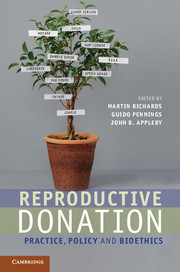Book contents
- Frontmatter
- Contents
- Contributors
- Acknowledgements
- 1 Introduction
- 2 The biology of donation
- 3 Ethics for reproductive donation
- 4 Parenthood – whose right is it anyway?
- 5 Reproductive donation
- 6 UK and US perspectives on the regulation of gamete donation
- 7 Gamete and embryo donation
- 8 The legal and ethical regulation of transnational donation
- 9 Balancing ethical criteria for the recruitment of gamete donors
- 10 Challenges in intra-family donation
- 11 ARTs and the single parent
- 12 Reproductive donation and justice for gay and lesbian couples
- 13 Is disclosure in the best interests of children conceived by donation?
- 14 Identifiable donors and siblings
- 15 Ethical issues in embryo donation
- 16 Reproduction through surrogacy
- 17 Some conclusions regarding the interaction of normative and descriptive elements in reproductive donation
- Index
17 - Some conclusions regarding the interaction of normative and descriptive elements in reproductive donation
Published online by Cambridge University Press: 05 August 2012
- Frontmatter
- Contents
- Contributors
- Acknowledgements
- 1 Introduction
- 2 The biology of donation
- 3 Ethics for reproductive donation
- 4 Parenthood – whose right is it anyway?
- 5 Reproductive donation
- 6 UK and US perspectives on the regulation of gamete donation
- 7 Gamete and embryo donation
- 8 The legal and ethical regulation of transnational donation
- 9 Balancing ethical criteria for the recruitment of gamete donors
- 10 Challenges in intra-family donation
- 11 ARTs and the single parent
- 12 Reproductive donation and justice for gay and lesbian couples
- 13 Is disclosure in the best interests of children conceived by donation?
- 14 Identifiable donors and siblings
- 15 Ethical issues in embryo donation
- 16 Reproduction through surrogacy
- 17 Some conclusions regarding the interaction of normative and descriptive elements in reproductive donation
- Index
Summary
If one message jumps out of this book, it is the complexity of reproductive donation. There is a huge variety of cultural, legal and moral rules regarding third-party reproduction. The regulatory systems constantly evolve as the world in which they function evolves. This evolution can be seen in changes as diverse as modifications in value hierarchies (children’s rights versus parental rights), techno-scientific developments (egg banking after vitrification), expansion of the world wide web (donor offspring looking for their donor siblings) and low-cost airlines (reproductive tourism). Moreover, due to globalization and internationalization, systems infect each other across large distances. The abolition of donor anonymity in Sweden was picked up by Australian states and returned to Western Europe. Continually legislators are setting up social experiments by modifying the legislation of assisted reproduction. However, we will only learn from these experiments if we spend time and effort analysing and interpreting them. The wealth of information to be gathered from the different systems worldwide should enable us to better rule our own practice, to better predict what will happen if we alter things and to better reach the moral goals we have set.
The proximate endeavour of this book was to provide a state of the art of the scientific information on donation. The ultimate goal was to use this information to help with the adaptation of the normative systems that currently regulate the practice. Many legislations are not (or not always) based on the scientific evidence. As a consequence, the laws may have unforeseen, unwanted and/or unintended consequences. The introduction of the identification requirement for donors can illustrate this point. Donors who know that they will become identifiable to their donor children are reluctant to accept the current maximum limit on donor offspring. A considerable number of them limit their donation to one or two families. So while a reduction in the number of donors was predicted, the overall effect on the availability of gametes for use in the clinic is greater than predicted.
- Type
- Chapter
- Information
- Reproductive DonationPractice, Policy and Bioethics, pp. 308 - 310Publisher: Cambridge University PressPrint publication year: 2012



